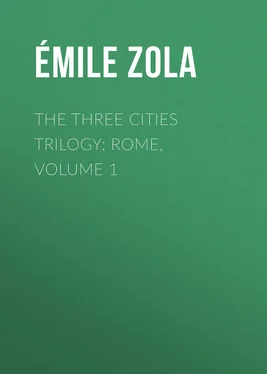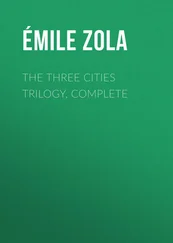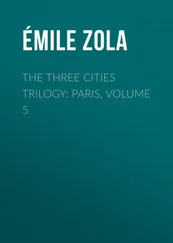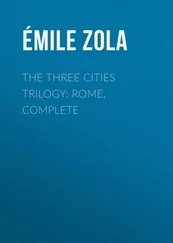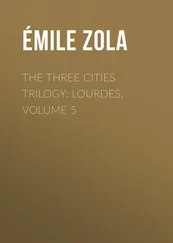Émile Zola - The Three Cities Trilogy - Rome, Volume 1
Здесь есть возможность читать онлайн «Émile Zola - The Three Cities Trilogy - Rome, Volume 1» — ознакомительный отрывок электронной книги совершенно бесплатно, а после прочтения отрывка купить полную версию. В некоторых случаях можно слушать аудио, скачать через торрент в формате fb2 и присутствует краткое содержание. Жанр: literature_19, foreign_antique, foreign_prose, на английском языке. Описание произведения, (предисловие) а так же отзывы посетителей доступны на портале библиотеки ЛибКат.
- Название:The Three Cities Trilogy: Rome, Volume 1
- Автор:
- Жанр:
- Год:неизвестен
- ISBN:нет данных
- Рейтинг книги:4 / 5. Голосов: 1
-
Избранное:Добавить в избранное
- Отзывы:
-
Ваша оценка:
- 80
- 1
- 2
- 3
- 4
- 5
The Three Cities Trilogy: Rome, Volume 1: краткое содержание, описание и аннотация
Предлагаем к чтению аннотацию, описание, краткое содержание или предисловие (зависит от того, что написал сам автор книги «The Three Cities Trilogy: Rome, Volume 1»). Если вы не нашли необходимую информацию о книге — напишите в комментариях, мы постараемся отыскать её.
The Three Cities Trilogy: Rome, Volume 1 — читать онлайн ознакомительный отрывок
Ниже представлен текст книги, разбитый по страницам. Система сохранения места последней прочитанной страницы, позволяет с удобством читать онлайн бесплатно книгу «The Three Cities Trilogy: Rome, Volume 1», без необходимости каждый раз заново искать на чём Вы остановились. Поставьте закладку, и сможете в любой момент перейти на страницу, на которой закончили чтение.
Интервал:
Закладка:
Émile Zola
The Three Cities Trilogy: Rome, Volume 1
PREFACE
IN submitting to the English-speaking public this second volume of M. Zola's trilogy "Lourdes, Rome, Paris," I have no prefatory remarks to offer on behalf of the author, whose views on Rome, its past, present, and future, will be found fully expounded in the following pages. That a book of this character will, like its forerunner "Lourdes," provoke considerable controversy is certain, but comment or rejoinder may well be postponed until that controversy has arisen. At present then I only desire to say, that in spite of the great labour which I have bestowed on this translation, I am sensible of its shortcomings, and in a work of such length, such intricacy, and such a wide range of subject, it will not be surprising if some slips are discovered. Any errors which may be pointed out to me, however, shall be rectified in subsequent editions. I have given, I think, the whole essence of M. Zola's text; but he himself has admitted to me that he has now and again allowed his pen to run away with him, and thus whilst sacrificing nothing of his sense I have at times abbreviated his phraseology so as slightly to condense the book. I may add that there are no chapter headings in the original, and that the circumstances under which the translation was made did not permit me to supply any whilst it was passing through the press; however, as some indication of the contents of the book – which treats of many more things than are usually found in novels – may be a convenience to the reader, I have prepared a table briefly epitomising the chief features of each successive chapter.
E. A. V.MERTON, SURREY, ENGLAND,
April, 1896.
PART I
I
THE train had been greatly delayed during the night between Pisa and Civita Vecchia, and it was close upon nine o'clock in the morning when, after a fatiguing journey of twenty-five hours' duration, Abbe Pierre Froment at last reached Rome. He had brought only a valise with him, and, springing hastily out of the railway carriage amidst the scramble of the arrival, he brushed the eager porters aside, intent on carrying his trifling luggage himself, so anxious was he to reach his destination, to be alone, and look around him. And almost immediately, on the Piazza dei Cinquecento, in front of the railway station, he climbed into one of the small open cabs ranged alongside the footwalk, and placed the valise near him after giving the driver this address:
"Via Giulia, Palazzo Boccanera." 1 1 Boccanera mansion, Julia Street.
It was a Monday, the 3rd of September, a beautifully bright and mild morning, with a clear sky overhead. The cabby, a plump little man with sparkling eyes and white teeth, smiled on realising by Pierre's accent that he had to deal with a French priest. Then he whipped up his lean horse, and the vehicle started off at the rapid pace customary to the clean and cheerful cabs of Rome. However, on reaching the Piazza delle Terme, after skirting the greenery of a little public garden, the man turned round, still smiling, and pointing to some ruins with his whip, "The baths of Diocletian," said he in broken French, like an obliging driver who is anxious to court favour with foreigners in order to secure their custom.
Then, at a fast trot, the vehicle descended the rapid slope of the Via Nazionale, which dips down from the summit of the Viminalis, 2 2 One of the seven hills on which Rome is built. The other six are the Capitoline, Aventine, Quirinal, Esquiline, Coelian, and Palatine. These names will perforce frequently occur in the present narrative.
where the railway station is situated. And from that moment the driver scarcely ceased turning round and pointing at the monuments with his whip. In this broad new thoroughfare there were only buildings of recent erection. Still, the wave of the cabman's whip became more pronounced and his voice rose to a higher key, with a somewhat ironical inflection, when he gave the name of a huge and still chalky pile on his left, a gigantic erection of stone, overladen with sculptured work-pediments and statues.
"The National Bank!" he said.
Pierre, however, during the week which had followed his resolve to make the journey, had spent wellnigh every day in studying Roman topography in maps and books. Thus he could have directed his steps to any given spot without inquiring his way, and he anticipated most of the driver's explanations. At the same time he was disconcerted by the sudden slopes, the perpetually recurring hills, on which certain districts rose, house above house, in terrace fashion. On his right-hand clumps of greenery were now climbing a height, and above them stretched a long bare yellow building of barrack or convent-like aspect.
"The Quirinal, the King's palace," said the driver.
Lower down, as the cab turned across a triangular square, Pierre, on raising his eyes, was delighted to perceive a sort of aerial garden high above him – a garden which was upheld by a lofty smooth wall, and whence the elegant and vigorous silhouette of a parasol pine, many centuries old, rose aloft into the limpid heavens. At this sight he realised all the pride and grace of Rome.
"The Villa Aldobrandini," the cabman called.
Then, yet lower down, there came a fleeting vision which decisively impassioned Pierre. The street again made a sudden bend, and in one corner, beyond a short dim alley, there was a blazing gap of light. On a lower level appeared a white square, a well of sunshine, filled with a blinding golden dust; and amidst all that morning glory there arose a gigantic marble column, gilt from base to summit on the side which the sun in rising had laved with its beams for wellnigh eighteen hundred years. And Pierre was surprised when the cabman told him the name of the column, for in his mind he had never pictured it soaring aloft in such a dazzling cavity with shadows all around. It was the column of Trajan.
The Via Nazionale turned for the last time at the foot of the slope. And then other names fell hastily from the driver's lips as his horse went on at a fast trot. There was the Palazzo Colonna, with its garden edged by meagre cypresses; the Palazzo Torlonia, almost ripped open by recent "improvements"; the Palazzo di Venezia, bare and fearsome, with its crenelated walls, its stern and tragic appearance, that of some fortress of the middle ages, forgotten there amidst the commonplace life of nowadays. Pierre's surprise increased at the unexpected aspect which certain buildings and streets presented; and the keenest blow of all was dealt him when the cabman with his whip triumphantly called his attention to the Corso, a long narrow thoroughfare, about as broad as Fleet Street, 3 3 M. Zola likens the Corso to the Rue St. Honore in Paris, but I have thought that an English comparison would be preferable in the present version. – Trans.
white with sunshine on the left, and black with shadows on the right, whilst at the far end the Piazza del Popolo (the Square of the People) showed like a bright star. Was this, then, the heart of the city, the vaunted promenade, the street brimful of life, whither flowed all the blood of Rome?
However, the cab was already entering the Corso Vittorio Emanuele, which follows the Via Nazionale, these being the two piercings effected right across the olden city from the railway station to the bridge of St. Angelo. On the left-hand the rounded apsis of the Gesu church looked quite golden in the morning brightness. Then, between the church and the heavy Altieri palace which the "improvers" had not dared to demolish, the street became narrower, and one entered into cold, damp shade. But a moment afterwards, before the facade of the Gesu, when the square was reached, the sun again appeared, dazzling, throwing golden sheets of light around; whilst afar off at the end of the Via di Ara Coeli, steeped in shadow, a glimpse could be caught of some sunlit palm-trees.
Читать дальшеИнтервал:
Закладка:
Похожие книги на «The Three Cities Trilogy: Rome, Volume 1»
Представляем Вашему вниманию похожие книги на «The Three Cities Trilogy: Rome, Volume 1» списком для выбора. Мы отобрали схожую по названию и смыслу литературу в надежде предоставить читателям больше вариантов отыскать новые, интересные, ещё непрочитанные произведения.
Обсуждение, отзывы о книге «The Three Cities Trilogy: Rome, Volume 1» и просто собственные мнения читателей. Оставьте ваши комментарии, напишите, что Вы думаете о произведении, его смысле или главных героях. Укажите что конкретно понравилось, а что нет, и почему Вы так считаете.
